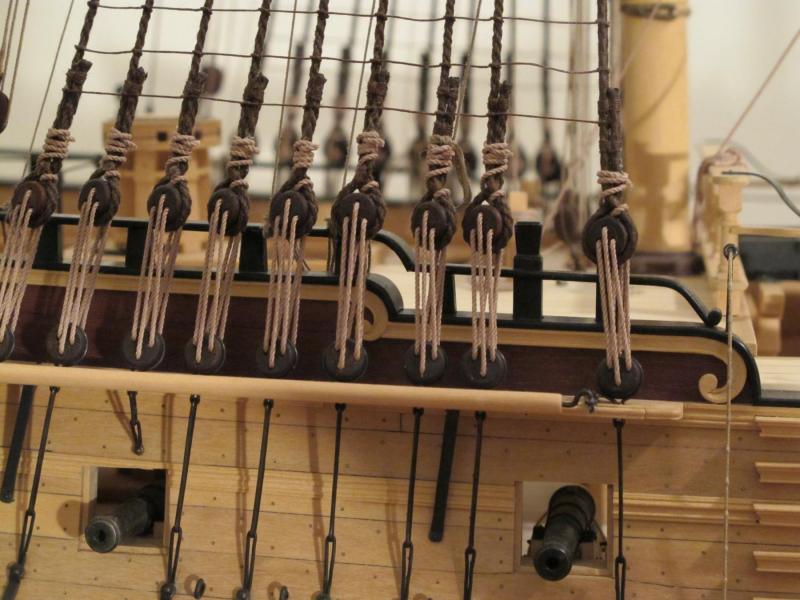-
Posts
13,290 -
Joined
-
Last visited
Content Type
Profiles
Forums
Gallery
Events
Everything posted by druxey
-
Usually the sides of the ports were vertical, as you have in 'C'. However, depending on the ship, if there were drag (floating lower at the stern than bow) the ports would appear as if 'leaning' backwards. The frames were normally set upright on the keel, the sides of the frames forming the sides of the ports.
-

How to deal with badly drawn plans?
druxey replied to Redshirt's topic in CAD and 3D Modelling/Drafting Plans with Software
I'd forgotten to mention the David White series, which was excellent. Well worth hunting down indeed. -
Undoubtedly the Science Museum ship models are all in storage vaults somewhere in England.... I do not believe that they have been 'de-acquisitioned', or this would be public knowledge.
- 3,618 replies
-
- young america
- clipper
-
(and 1 more)
Tagged with:
-
I, too, use the small rechargeable butane torch seen in the photo on the right. I have also used an oxy/propane torch with interchangeable tips in a jeweler's studio. For larger pieces this will provide more even heating more rapidly.
- 749 replies
-
- albertic
- ocean liner
-
(and 2 more)
Tagged with:
-
It would be great if I could persuade folk to bend planks (by steam or dry heat) so that they would be shaped to 'sit' nicely along the hull without need for 'persuasion' by screws, clamps or other devices of torture!
-
Something like this from the RMG 'Collections' site? Object ID SLR2302 Description Scale: Unknown. A midship model showing a proposed method of hull construction with double-rigged iron frames and wooden planking. The model is made largely in wood with a planked hull and wooden frames to the upperworks. Two decks are depicted in frame, the main deck having a large hatch with a wooden edge. The deck beams are composite with wooden beams sandwiched between metal beams and with metal diagonal bracing. The deck below is identical in terms of composition and layout, but without the diagonal bracing. Two slender metal supports run vertically at either end of the section, fore and aft of the hatches, and terminating at the keelson. A paper label has been applied to the edge of the main deck hatch frame marked "15". Date made circa 1864 Read more at http://collections.rmg.co.uk/collections/objects/68261.html#SwHmmpfrbz0IJQCp.99
-

How to deal with badly drawn plans?
druxey replied to Redshirt's topic in CAD and 3D Modelling/Drafting Plans with Software
...aaand - down the rabbit hole you go! -

How to deal with badly drawn plans?
druxey replied to Redshirt's topic in CAD and 3D Modelling/Drafting Plans with Software
Not wanting to put you off, Gemma, but there's an awful lot to learn about naval architecture! One article that is helpful in basics was published many years ago in Model Shipwright. No's 22, 23. I'm PM'ing you information. -
Yes, that Longridge book is a nostalgic one for all the pre-war sources of materials that existed then. Unlike his Anatomy of Nelson's Ships, there is little on hull structure. A framed model of Cutty Sark would be a nice challenge for Gerald Wingrove! How about it, Gerald?
- 3,618 replies
-
- young america
- clipper
-
(and 1 more)
Tagged with:
-
Very neatly done, Toni. I like the clerestory lights.
- 1,449 replies
-
Nice to see your progress, Michael. Enjoy using your new micro-torch with that beautifully engineered third hand. Is the torch oxy-propane?
- 749 replies
-
- albertic
- ocean liner
-
(and 2 more)
Tagged with:
-
Longridge also had a two-volume book published on building the model.
- 3,618 replies
-
- young america
- clipper
-
(and 1 more)
Tagged with:
-
Welcome aboard, Kiran. We look forward to seeing what you've been modelling.
-

PRINS WILLEM by juzek
druxey replied to juzek's topic in - Build logs for subjects built 1501 - 1750
Very interesting building techniques, Andrzej! Nicely done. -
Unlike the unfortunate Captain, I hope you return! She looks to be taking shape quite nicely now, Steven. You seem to have cornered the market for push pins.
-
That's remarkably good miniature turning on the Unimat, John!
- 30 replies
-
- philadelphia
- diorama
-
(and 3 more)
Tagged with:
About us
Modelshipworld - Advancing Ship Modeling through Research
SSL Secured
Your security is important for us so this Website is SSL-Secured
NRG Mailing Address
Nautical Research Guild
237 South Lincoln Street
Westmont IL, 60559-1917
Model Ship World ® and the MSW logo are Registered Trademarks, and belong to the Nautical Research Guild (United States Patent and Trademark Office: No. 6,929,264 & No. 6,929,274, registered Dec. 20, 2022)
Helpful Links
About the NRG
If you enjoy building ship models that are historically accurate as well as beautiful, then The Nautical Research Guild (NRG) is just right for you.
The Guild is a non-profit educational organization whose mission is to “Advance Ship Modeling Through Research”. We provide support to our members in their efforts to raise the quality of their model ships.
The Nautical Research Guild has published our world-renowned quarterly magazine, The Nautical Research Journal, since 1955. The pages of the Journal are full of articles by accomplished ship modelers who show you how they create those exquisite details on their models, and by maritime historians who show you the correct details to build. The Journal is available in both print and digital editions. Go to the NRG web site (www.thenrg.org) to download a complimentary digital copy of the Journal. The NRG also publishes plan sets, books and compilations of back issues of the Journal and the former Ships in Scale and Model Ship Builder magazines.



